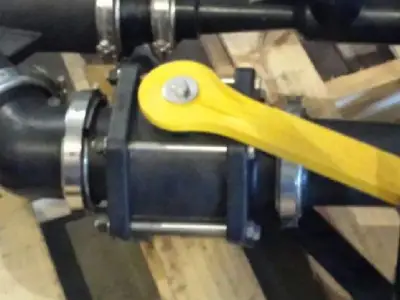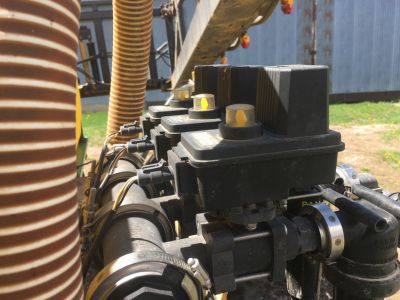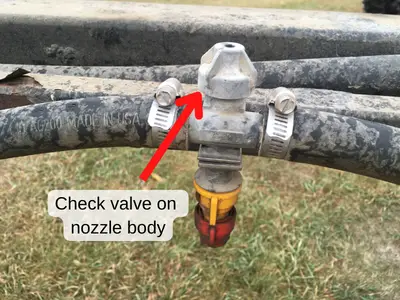

Agricultural equipment has come a long way in terms of efficiency and precision. One crucial component that plays a pivotal role in this is sprayer valves. In this comprehensive guide, we will delve into the world of sprayer valves, understanding their various types, factors to consider when choosing the right one, and the benefits they offer to modern agriculture.
Without valves, a sprayer is very hard to control. While the sprayer pump provides the flow, valves are what facilitate the different functions of a sprayer. You can direct flow to different boom sections, agitate the liquid in the tank, and increase or decrease the sprayer’s output.

Different types of valves are required to accomplish all of these various functions. They vary in size, type, and function. Let’s go ahead and examine how valves differ and why.
There are typically several different sizes of valves used on a sprayer. From large on/off valves on the tank outlet to small drain valves on a strainer. The reason there are so many different sizes is that the amount of liquid that needs to pass through each valve varies depending on the specific spot in the sprayer plumbing.
The largest valves will be used as tank fill valves and in the main suction line from the primary outlet on the tank that feeds liquid to the sprayer pump. The size of these valves used will vary depending on the sprayer but the outlet valve on the tank should have a fluid path (inside diameter) at least as large as the inlet of the pump.
Various sizes of valves are used throughout the rest of the sprayer. Again, the size of the valve will be dependent on the flow that is required for that specific fluid path. If you are building a sprayer, be sure to review this guide to help with your plumbing.

Quarter turn, polypropylene ball valves are one of the most common types of valves used on sprayers. They are chemical resistant, don’t rust, and they are durable.

Electric valves are pivotal components in precision spraying applications. They allow the operator of a sprayer to remotely control the flow of fluid in the system. These valves can be simply on/off valves that are used to either stop the flow to a boom section or other accessory, or they can be regulating valves.
Boom section control is possible with a set of electronic valves that are mounted together on a sprayer to create a manifold. The boom is divided into different sections that correspond with a valve in the manifold. This provides a more precise application of pesticides, fertilizers, etc. Rather than the entire boom being “on” or “off”, specific sections can be shut off when not needed.
When it comes to agricultural sprayers there are two primary types of electric valves used: solenoid valves and motorized ball valves. While they are both used to turn on/off valves from the sprayer/tractor cab with a switch, they differ in how they operate.
Motorized valves are typically a much better choice for ag use. They are more durable and the motors will last much longer. However, they do tend to be more expensive. You can read my guide on solenoid vs. motorized ball valves to see which one would be better for your application.
Manual Regulating – A manual regulating valve is a mechanically operated valve that controls the flow and pressure of the liquid being sprayed. It is adjusted via a control knob.
The primary function of a regulating valve is to maintain the operating pressure within a system. A manual regulating valve has a bypass that sends excess liquid back to the supply tank.

Electronic Regulating Valves – Electronic regulating valves offer precise control over the rate at which liquid is applied. They are commonly used on large agricultural sprayers and anti-ice sprayers where the rate needs to be adjusted automatically as the travel speed changes.
Unlike manual valves, these are controlled electronically, often through a control console or a remote switch box. These types of regulating valves work in tandem with a flow meter to maintain the desired application rate.
Regulating valves play a crucial role in precision agriculture. If you are interested in learning more about how a regulating valve works with other components to maintain a consistent application rate, then be sure to read this article on automatic rate control setups.

Gate valves are used in applications where the flow needs to be controlled but not precisely. For example, on a sprayer, you might want to direct a portion of the flow back to the tank to agitate the spray solution. A gate valve allows you to throttle or adjust the amount going back to the tank manually. When you are not spraying, the valve can be opened more to increase the agitation rate.
Gate valves operate by lifting a gate out of the path of the fluid. These valves typically have a wheel on top of a stem that attaches to the gate inside of the valve body.
A three-way valve typically has three ports or connections. These are commonly referred to as an inlet and two outlets, or vice versa, depending on the valve’s function and the system’s design.

Three-way valves are used to control the direction of the fluid flow. This can be crucial in systems where the fluid needs to be selectively directed between different paths, such as directing flow to an inductor tank for mixing.

A check valve is designed to allow fluid (like water, pesticide, or herbicide) to flow in only one direction. It typically consists of a valve body, a seat, and a movable part (often a diaphragm) that blocks reverse flow. They will only open when the system pressure reaches a certain point. This is called the cracking pressure and on a sprayer, it is typically anywhere from 1-20 psi depending on the application.
In sprayer nozzle bodies, check valves are crucial for preventing the dripping of chemicals when the sprayer is turned off or when there’s a decrease in pressure.
Valves on an agricultural boom sprayer play several crucial roles in ensuring the effective and efficient operation of the spraying system. Here’s a breakdown of their primary functions:
Different sprayer valves work together with a rate controller to allow the operator to automatically adjust the sprayer’s output. You can learn more about automatic sprayer control in this guide to electronic sprayer control setups.
Depending on the sprayer type, there may be several valves on a sprayer. One of the primary uses of manual ball valves in sprayer systems is to control and switch between different accessories or to alter the sprayer’s mode of operation.

Take, for example, an agricultural boom sprayer. Typically, these sprayers are equipped with a high-volume pump. A manifold on the discharge side of the pump with multiple valves allows the pump to perform various tasks simultaneously, based on the operator’s needs.
By opening or closing different ball valves, the operator can direct the flow of liquid to specific parts of the sprayer, enabling it to perform multiple functions. This could range from powering the main boom to operating additional features like agitation, mixing tanks, or recirculation systems.
Electronic valves further enhance the functionality of sprayers. These valves offer the same capabilities as manual ball valves but with the added benefit of remote control. This means that an operator, comfortably seated in the cab of a sprayer, tractor, or truck, can make on-the-fly adjustments to the sprayer’s output.
Many types of valves can be used on just about any sprayer. For example, ball valves, gate valves, and check valves don’t care where you use them as long as they are rated to handle your operating pressure and they are made from materials that will hold up to the liquid benign sprayed.
Understanding the different types of sprayer valves and their specific functions is key to optimizing your spraying operations. Whether it’s managing flow, pressure, direction, or simply turning the spray on and off, the right valve can make a significant difference in the efficiency and effectiveness of your sprayer. Always consider your specific needs and the characteristics of your sprayer system when selecting valves.
I have more than a decade of experience using, building, studying, and testing sprayers in several applications. With the knowledge I have gained I want to provide straight forward and detailed answers for DIY homeowners, farmers, and commercial turf and tree care pros.
A sprayer is an important piece of equipment for farmers, ranchers, turf care professionals, and even homeowners. This essential tool has revolutionized the way we control weeds and pests, but have.
Welcome! Sprayerguru.com is the place to get detailed answers on all types of sprayers and sprayer components. Whether you are needing guidance on lawn and garden sprayers, tree sprayers, or agricultural sprayers, you can find answers here.
Sprayerguru.com is a participant in the following affiliate programs: Amazon, Jobber, CJ, and Share-A-Sale. Some of the links provided are affiliate links and we may receive a small commission for referring products at no cost to you. The information provided on this site is based on many years of experience however, operating sprayers comes with many risks. From high pressures to harmful liquids. It is vital to always follow product labels and manufacturer guidelines when spraying. By reading the information on this site you are understanding these risks and that sprayerguru.com or it's writers are not responsible for any errors, accidents, or issues that you may encounter.